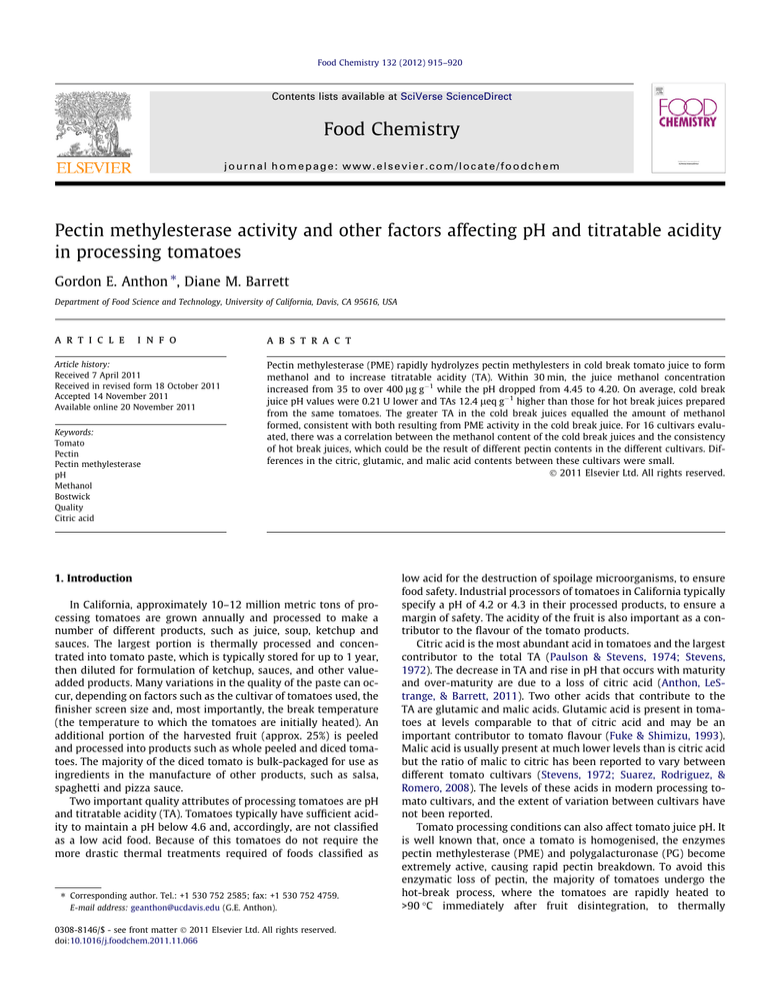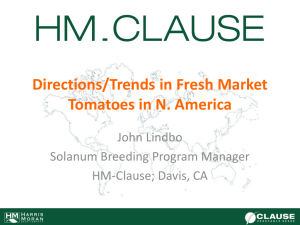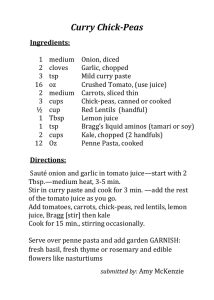
Food Chemistry 132 (2012) 915–920
Contents lists available at SciVerse ScienceDirect
Food Chemistry
journal homepage: www.elsevier.com/locate/foodchem
Pectin methylesterase activity and other factors affecting pH and titratable acidity
in processing tomatoes
Gordon E. Anthon ⇑, Diane M. Barrett
Department of Food Science and Technology, University of California, Davis, CA 95616, USA
a r t i c l e
i n f o
Article history:
Received 7 April 2011
Received in revised form 18 October 2011
Accepted 14 November 2011
Available online 20 November 2011
Keywords:
Tomato
Pectin
Pectin methylesterase
pH
Methanol
Bostwick
Quality
Citric acid
a b s t r a c t
Pectin methylesterase (PME) rapidly hydrolyzes pectin methylesters in cold break tomato juice to form
methanol and to increase titratable acidity (TA). Within 30 min, the juice methanol concentration
increased from 35 to over 400 lg g 1 while the pH dropped from 4.45 to 4.20. On average, cold break
juice pH values were 0.21 U lower and TAs 12.4 leq g 1 higher than those for hot break juices prepared
from the same tomatoes. The greater TA in the cold break juices equalled the amount of methanol
formed, consistent with both resulting from PME activity in the cold break juice. For 16 cultivars evaluated, there was a correlation between the methanol content of the cold break juices and the consistency
of hot break juices, which could be the result of different pectin contents in the different cultivars. Differences in the citric, glutamic, and malic acid contents between these cultivars were small.
Ó 2011 Elsevier Ltd. All rights reserved.
1. Introduction
In California, approximately 10–12 million metric tons of processing tomatoes are grown annually and processed to make a
number of different products, such as juice, soup, ketchup and
sauces. The largest portion is thermally processed and concentrated into tomato paste, which is typically stored for up to 1 year,
then diluted for formulation of ketchup, sauces, and other valueadded products. Many variations in the quality of the paste can occur, depending on factors such as the cultivar of tomatoes used, the
finisher screen size and, most importantly, the break temperature
(the temperature to which the tomatoes are initially heated). An
additional portion of the harvested fruit (approx. 25%) is peeled
and processed into products such as whole peeled and diced tomatoes. The majority of the diced tomato is bulk-packaged for use as
ingredients in the manufacture of other products, such as salsa,
spaghetti and pizza sauce.
Two important quality attributes of processing tomatoes are pH
and titratable acidity (TA). Tomatoes typically have sufficient acidity to maintain a pH below 4.6 and, accordingly, are not classified
as a low acid food. Because of this tomatoes do not require the
more drastic thermal treatments required of foods classified as
⇑ Corresponding author. Tel.: +1 530 752 2585; fax: +1 530 752 4759.
E-mail address: geanthon@ucdavis.edu (G.E. Anthon).
0308-8146/$ - see front matter Ó 2011 Elsevier Ltd. All rights reserved.
doi:10.1016/j.foodchem.2011.11.066
low acid for the destruction of spoilage microorganisms, to ensure
food safety. Industrial processors of tomatoes in California typically
specify a pH of 4.2 or 4.3 in their processed products, to ensure a
margin of safety. The acidity of the fruit is also important as a contributor to the flavour of the tomato products.
Citric acid is the most abundant acid in tomatoes and the largest
contributor to the total TA (Paulson & Stevens, 1974; Stevens,
1972). The decrease in TA and rise in pH that occurs with maturity
and over-maturity are due to a loss of citric acid (Anthon, LeStrange, & Barrett, 2011). Two other acids that contribute to the
TA are glutamic and malic acids. Glutamic acid is present in tomatoes at levels comparable to that of citric acid and may be an
important contributor to tomato flavour (Fuke & Shimizu, 1993).
Malic acid is usually present at much lower levels than is citric acid
but the ratio of malic to citric has been reported to vary between
different tomato cultivars (Stevens, 1972; Suarez, Rodriguez, &
Romero, 2008). The levels of these acids in modern processing tomato cultivars, and the extent of variation between cultivars have
not been reported.
Tomato processing conditions can also affect tomato juice pH. It
is well known that, once a tomato is homogenised, the enzymes
pectin methylesterase (PME) and polygalacturonase (PG) become
extremely active, causing rapid pectin breakdown. To avoid this
enzymatic loss of pectin, the majority of tomatoes undergo the
hot-break process, where the tomatoes are rapidly heated to
>90 °C immediately after fruit disintegration, to thermally
916
G.E. Anthon, D.M. Barrett / Food Chemistry 132 (2012) 915–920
inactivate PME and PG and prevent the enzymatic breakdown of
pectins (Barrett, Garcia, & Wayne, 1998; Luh & Daoud, 1971;
McColloch, Nielsen, & Beavens, 1950). The hydrolysis of pectin by
PME and PG is an important issue for tomato processors because
the loss of pectin reduces juice viscosity. Less widely recognised
is the fact that the hydrolysis of pectin methylesters by PME will
also alter the pH and TA of the tomato juice because of the additional galacturonic acid residues produced by methylester hydrolysis. Tomato juice prepared without heating, commonly referred to
as a cold break juice, has been shown to have greater acidity and a
lower pH than a hot break juice produced from the same tomatoes
(Stadtman, Buhlert, & Marsh, 1977). While it is generally accepted
that pectin hydrolysis occurs in a cold break juice, there are few
published reports that clearly illustrate just how quickly these
enzymatic reactions will occur after fruit homogenisation. In particular, the speed and extent to which PME de-esterifies pectin in
a tomato homogenate have not been previously shown. With enzymatically active cell wall material, pectin de-esterification by PME
was reported to occur within 10 min (Koch & Nevins, 1989). The
rate of de-esterification in tomato juice produced from whole
tomatoes has not been reported.
Here we have examined, in greater detail, the changes in pH and
TA caused by PME activity occurring after tomato homogenisation.
We have also measured the difference in pH and TA between hot
and cold break juices with a much larger sample size than those
analysed previously, to obtain a more accurate estimate of the
magnitude of the changes in pH and TA due to PME activity. In
addition, we have measured the citric, glutamic and malic acid
contents in juice from a number of processing tomato cultivars,
to determine whether there is significant variation in acid composition between cultivars, and to estimate the relative contributions
of different acids to the measured total TA.
2. Materials and methods
2.1. Materials
et al., 2007). Cold break juices were allowed to stand at room temperature for at least 1 h between blending and analysis.
2.4. Methanol assay
Methanol concentrations in the cold break juices were determined using alcohol oxidase and Purpald, as described previously
(Anthon & Barrett, 2004). To determine the rate of methanol formation in a tomato homogenate, a single roma type tomato (cultivar not known) was homogenised in a blender; then, at various
times after the start of homogenisation, 0.1 ml aliquots of juice
were removed and mixed with an equal volume of 0.1 M phosphate buffer (pH 2.0) containing 1 g l 1 of sodium lauryl sulphate.
We have previously shown that this buffered detergent solution
inactivates PME, preventing any further methanol formation (Anthon & Barrett, 2010). To estimate the methanol concentration in
the fruit prior to homogenisation additional tomatoes were
homogenised directly in an equal volume of the buffered detergent
solution, to prevent any PME activity from occurring. These juice
samples were analysed for methanol, using alcohol oxidase and
Purpald, as described previously (Anthon & Barrett, 2004). Control
experiments showed that sodium lauryl sulphate, at the concentrations used here, did not inhibit alcohol oxidase or interfere with
the determination of methanol.
2.5. Organic acids
Supernatants were prepared from these juices by centrifuging
at 15,000g for 5 min. Suitable dilutions of these supernatants were
analysed for citric, malic and glutamic acids using enzyme kits (RBiopharm, Marshall, MI) in a 96-well plate format, as described
(Vermeir, Nicolai, Jans, Maes, & Lammertyn, 2007). It has been
shown that acid levels, determined with these kits on crude tomato
juice supernatants, show excellent agreement with HPLC analysis
(Vermeir et al., 2007). Phosphate concentrations were determined
by the method of Ames (1966) with the reagent volumes modified
to a final volume of 0.2 ml for use in a 96-well plate format.
All chemical reagents were obtained from Sigma (St. Louis, MO).
2.6. Statistical methods
2.2. Tomatoes
In 2009, 16 processing tomato cultivars were grown in five
counties in California. For each cultivar, two replicate plantings
were made in each county, resulting in a total of 10 replicate plantings for each cultivar and an overall total of 160 samples. In 2010,
16 cultivars were again grown but only four counties were used,
resulting in a total of eight replicate plantings for each cultivar
and an overall total of 128 samples. Of the 16 cultivars grown in
2010, seven were the same as in 2009 and nine were different. Ripe
fruit was harvested as described previously (Garcia & Barrett,
2006).
2.3. Preparation and evaluation of juices
Preparation of hot and cold break tomato juices were as described previously (Barrett, Weakley, Diaz, & Watnik, 2007). Individual tomatoes were cut in half, lengthwise, and the halves
separated to form two samples of approximately 1300 g each. Cold
break juice was prepared from one of the samples by homogenising the tomato halves in a blender. A hot break juice was prepared
from the other 1300 g sample by heating in a 1400 W commercial
microwave oven for 6 min at 100% power, followed by 6 min at 50%
power. Both juices were analysed for titratable acidity, pH and soluble solids; Bostwick juice consistency was determined on the hot
break juice only. Assays were performed as described (Barrett
Means, standard deviations, and correlations were calculated
using statistical functions in Microsoft Excel.
3. Results and discussion
3.1. Methanol and acid formation by PME
It is well known that, when a tomato is disintegrated without
heating, PME is released into the juice and rapidly hydrolyzes the
methylesters in the pectin, producing methanol and polygalacturonic acid. This polygalacturonic acid can then be further hydrolysed into oligomers and monomers of galacturonic acid by PG. The
speed with which PME de-esterifies pectins in a cold break juice
was determined by homogenising a tomato in a blender and allowing the juice to stand at room temperature. A typical time course
shows that methanol was rapidly produced in the tomato homogenate (Fig. 1). The initial level of methanol in the fruit, prior to
homogenisation, was determined by homogenising additional
tomatoes under conditions that rapidly inactivate PME, preventing
any pectin ester hydrolysis. A methanol content of 35 ± 11 lg g 1
(n = 4) was determined, which is similar to what we have found
previously (Anthon & Barrett, 2010). From this initial level, the
methanol concentration in the homogenate increased to
198 lg g 1 by 2 min and to more than 400 lg g 1 by 30 min. In
parallel with this increase in methanol concentration, was a
917
G.E. Anthon, D.M. Barrett / Food Chemistry 132 (2012) 915–920
4.45
A
500
4.4
4.8
Hot break juice pH
400
pH
4.3
200
4.25
100
4.2
4.15
Methanol (µg g -1)
4.35
300
10
20
4.6
4.4
y = 0.8666x + 0.8065
R² = 0.7741
4.2
4.0
4.0
0
0
5.0
30
4.2
B
Hot break juice TA ( eq g-1)
Fig. 1. Decrease in pH (j) and increase in methanol content (e) in a cold break
tomato juice.
decrease in the pH. From an initial pH of about 4.45 the pH
dropped to less than 4.20 after 30 min. The pH change after
homogenisation cannot be determined exactly because, by the
time the first pH measurement could be made (15 s after the start
of homogenisation), the pH was already rapidly dropping. In addition to producing methanol, the hydrolysis of methylesters by PME
results in the formation of acidity (Hagerman & Austin, 1986; Kertesz, 1937). The drop in pH, in parallel with the increase in methanol concentration, is consistent with a de-esterification of pectin
by PME in the tomato juice.
Unlike in a cold break tomato juice, in a hot break tomato juice,
the tomatoes are heated to inactivate PME and other enzymes prior
to homogenisation, preventing any breakdown of the pectins in the
juice. Microwave heating of whole fruit prior to homogenisation is
a commonly used method for preparing hot break juices. We have
previously shown that such microwave hot break juice contains no
greater amount of methanol than that found in the intact fruit,
indicating a complete inactivation of PME (Anthon & Barrett,
2010). The magnitude of the pH change resulting from PME activity
in cold-broken tomatoes was determined by comparing the pH values of hot and cold break tomato juices prepared from the same
tomatoes. Tomatoes were cut in half lengthwise, and a microwave
hot break juice was prepared from one set of halves and a cold
break juice from the other set. A plot of pH values of the hot break
juices versus those of the cold break juices showed that the two
were correlated (r2 = 0.77) but, as expected, because PME was inactivated in the hot break juice, the pH values of the hot break juices
were always higher (Fig. 2A). The pH of the cold break juices ranged from 4.04 to 4.65 while the hot break juices ranged from
4.31 to 4.86. The average differences in pH between the hot and
cold break juices were 0.23 ± 0.06 for the juices prepared in 2009
and 0.19 ± 0.03 for the juices prepared in 2010 (Table 1).
Cold break juices had higher TA than had hot break juices. The
TA values in the cold break juices ranged from 35 to 68 leq g 1
versus 25 to 56 leq g 1 in the hot break juices (Fig. 2B). The average differences in TA between the hot and cold break juices were
12.4 ± 2.24 leq g 1 in 2009 and 12.4 ± 1.33 leq g 1 in 2010 (Table
1). These values are equal to about one third of the total TA measured for the hot break juices. Put another way, about one quarter
of the total measured TA in the cold broken tomato juices was from
acids formed enzymatically after the tomatoes were homogenised.
The average methanol concentration in the cold break juices prepared in 2010 was 11.5 ± 1.12 lmol g 1 (Table 1). This amount of
methanol is essentially equal to, on a molar basis, the amount of
in TA in the cold break juices formed after homogenisation
(12.4 ± 1.33 leq g 1), as would be expected if both are the result
4.4
4.6
4.8
5.0
Cold break juice pH
Time after homogenisation (min)
70
y = 0.8787x - 6.3746
R² = 0.8888
60
50
40
30
20
20
30
40
50
60
70
Cold break juice TA (µ eq g-1)
Fig. 2. pH and TA for hot and cold break juices prepared in 2009. (A) pH (B) TA.
Table 1
Differences in pH and TA between hot and cold break juices. Methanol was measured
on the 2010 cold break samples only.
pH
TA (leq g
1
)
Methanol (lmole g
Brix
1
)
Year
Cold break
Hot break
2009
2010
4.34 ± 0.12
4.31 ± 0.08
4.57 ± 0.12
4.51 ± 0.09
0.23 ± 0.06
0.19 ± 0.03
2009
2010
49.8 ± 6.7
51.4 ± 6.2
37.3 ± 6.3
38.9 ± 5.7
12.4 ± 2.3
12.4 ± 1.3
5.13 ± 0.45
5.37 ± 0.48
0.02 ± 0.32
0.02 ± 0.16
2010
11.5 ± 1.1
2009
2010
5.15 ± 0.54
5.38 ± 0.53
Difference
of PME activity. Total soluble solids contents were not different between the hot and cold break juices (Table 1).
Stadtman et al. (1977) were the first to report that hot break tomato juices have higher pHs and lower TAs than have cold break
juices, and that these differences were the result of PME activity
occurring after fruit homogenisation. However, they found that
the average difference in pH between hot and cold break juices
was about 0.10 pH units and the average difference in TA was
5.0 leq g 1. These differences are only half as large as those found
here. In a more recent study, hot and cold break juices were prepared from processing tomato cultivars similar to those used here.
Surprisingly, no difference in pH or TA between the hot and cold
break juices were noted (Akbudak, 2010). In both of these previous
instances the tomatoes were disintegrated then heated by conventional thermal processing. It is possible that these hot break methods were less effective than the microwave procedure that we used
G.E. Anthon, D.M. Barrett / Food Chemistry 132 (2012) 915–920
here for rapid enzyme inactivation. This could have allowed for
more PME activity to occur in their hot break juices prior to complete enzyme inactivation, increasing the TAs of these juices and
resulting in less apparent difference between their hot and cold
break juices. Consistent with this, in both of these previous studies,
the TA values of their hot break juices were mostly greater than
50 leq g 1, which is higher than the range of 30–50 leq g 1 found
here (Fig. 2).
A
3.2. Cultivar differences
Table 2
Cultivar differences for methanol content of cold break juices, TA differences between
hot and cold break juices, and Bostwick values of hot break juices for juices prepared
in 2010. Cultivars are ranked from highest to lowest methanol content.
Methanol (lmol g
H 5608
H 8504
UG 19406
H 5508
CXD 282
H 9780
Nun 6385
HMX 7885
CXD 255
H 4007
AB 3
BQ 163
Nun 6394
AB 2
BQ 205
SUN 6366
13.5
12.8
12.8
12.3
12.2
12.0
11.8
11.7
11.5
11.2
10.7
10.6
10.4
10.3
10.2
9.5
16
14
R² = 0.8954
12
1
)
TA diff. (leq g
14.7
14.0
13.9
12.8
12.8
13.0
12.9
12.8
12.9
12.5
11.6
11.9
10.6
11.0
10.5
10.1
1
)
Bostwick (cm)
12.9
13.0
14.0
13.5
13.5
13.5
13.9
15.2
14.8
16.4
16.9
17.3
16.6
18.1
17.9
18.4
10
9
10
11
12
13
14
Methanol ( µ mole- g 1)
B
20
18
Bostwick (cm)
The average amounts of methanol in the cold break juices were
different for different tomato cultivars. Cultivars with the greatest
amount of methanol also showed the largest difference in TA between hot and cold break juices, consistent with both resulting
from PME activity in the cold break juice (Table 2). Processing tomato cultivars are known to vary in pectin content, which could
account for the variable amounts of methanol formed in the cold
break juices from different cultivars. Pectin content is also an
important determinant of juice consistency. Cultivars with high
pectin content generally produce hot-break juices with high gross
viscosities. Gross viscosities of tomato juices are typically measured with a Bostwick consistometer, in which the distance a defined volume of juice flows in 30 s is determined. A low Bostwick
value indicates a high gross viscosity. Thus cultivars with high pectin content would be expected to produce hot break juices with
low Bostwick values and cold break juices with high methanol content. Consistent with this, for the 16 cultivars of tomatoes analysed, there was a significant correlation (p < 0.001) between the
Bostwick values of hot break juices and the methanol contents of
cold break juice prepared from the same tomatoes (Fig. 3). Cultivars with low Bostwick values contained more methanol in their
cold break juices and had larger differences in TA between hot
and cold break juices than had cultivars with high Bostwick values
(Table 2). The extent to which the pectin galacturonic acid residues
are methylesterified can vary for pectins from different sources.
Thus, an assumption (in using the methanol concentration of the
cold break juice as a measure of the pectin content in the fruit) is
that this degree of pectin methylesterification does not vary appreciably between different tomato cultivars. The good correlation between methanol content and juice consistency suggests that such
is the case. A possible practical application for this correlation
would be as a screening tool in selecting for consistency in processing tomatoes cultivars.
Cultivar
20
18
Bostwick (cm)
918
16
14
R² = 0.8054
12
10
9
10
11
12
13
14
15
TA difference ( µ eq g 1)
Fig. 3. (A) Correlation between average Bostwick values of hot break juices and the
average methanol contents of cold break juices for 16 cultivars of tomatoes. (B)
Correlation between average Bostwick values of hot break juices and the average
difference in TA between hot and cold break juices prepared from 16 cultivars of
tomatoes.
The pH of the tomato is an important fruit quality measure that
is often reported in cultivar evaluations or in studies on growing
conditions (Gautier et al., 2008; Loiudice et al., 1995; Oke, Ahn,
Schofield, & Paliyath, 2005; Suarez et al., 2008). In nearly all cases,
the measurements are made on cold-break juices with no attempt
to inactivate PME prior to homogenisation. Authors have not routinely reported how quickly pH was measured after homogenisation nor whether this time interval was consistent for different
samples. In tomatoes, due to the high activity of PME, the length
of this time interval will affect the measured pH (Fig. 1). The pH
values reported thus do not represent the pH of the intact tomato,
nor will they accurately reflect the pH to be expected if the tomato
is to be processed by hot-break methods. Since the amount of acidity formed in cold break juices were different for different cultivars
(Table 2), meaningful comparisons of TA and pH between cultivars
are best obtained from hot break juices.
3.3. Organic acids
To assess the influence of individual organic acids on the pH and
TA of hot break tomato juice, the concentration of citric, malic, and
glutamic acids were measured for the 128 juice samples analysed
in 2010. In agreement with others (Loiudice et al., 1995; Paulson &
Stevens, 1974; Stevens, 1972; Suarez et al., 2008), citric acid was
the most abundant acid with an average of concentration of
2.54 mg g 1 (range 1.29–3.76 mg g 1). Glutamic acid was present
at a concentration similar to that of citric acid, with an average
concentration of 2.11 mg g 1 (range of 1.00–3.21 mg g 1). The
919
G.E. Anthon, D.M. Barrett / Food Chemistry 132 (2012) 915–920
Table 3
Average pH and acid contents of hot break juices from 16 processing tomato cultivars grown in 2010. Values are mean ± SD (n = 8).
Cultivar
pH
TA (leq g
UG 19406
H 8504
H 5508
AB 2
BQ 205
H 9780
BQ 163
AB 3
H 5608
H 4007
SUN 6366
CXD 255
Nun 6385
Nun 6394
CXD 282
HMX 7885
4.37 ± 0.05
4.39 ± 0.06
4.45 ± 0.05
4.43 ± 0.09
4.46 ± 0.06
4.46 ± 0.04
4.51 ± 0.06
4.49 ± 0.06
4.51 ± 0.06
4.58 ± 0.07
4.54 ± 0.06
4.51 ± 0.06
4.54 ± 0.06
4.58 ± 0.07
4.57 ± 0.08
4.72 ± 0.07
47.5 ± 5.60
46.3 ± 4.16
44.3 ± 3.06
43.8 ± 3.85
42.6 ± 4.44
42.4 ± 4.45
42.3 ± 4.36
41.5 ± 3.89
37.8 ± 4.35
37.0 ± 4.91
35.6 ± 3.51
35.1 ± 3.48
33.7 ± 2.79
32.6 ± 2.97
32.0 ± 2.78
28.2 ± 2.58
1
)
Citric acid (mg g
1
)
3.12 ± 0.45
2.92 ± 0.51
3.09 ± 0.50
2.81 ± 0.53
2.89 ± 0.57
2.84 ± 0.39
2.74 ± 0.57
2.98 ± 0.50
2.93 ± 0.42
2.83 ± 0.53
2.41 ± 0.48
2.09 ± 0.50
2.46 ± 0.48
2.34 ± 0.40
2.11 ± 0.38
2.11 ± 0.37
average malic acid concentration was much lower at 0.31 mg g 1
(range 0.187–0.508 mg g 1). Inorganic phosphate ions will also
influence the TA and pH. Average phosphate concentration was
2.41 lmol g 1 (range of 1.31–3.64 lmol g 1) in these juices.
From the measured concentration of each individual acid, such
as citric acid, the known pKa’s of this acid, and the measured pH of
the juice, a value can be calculated for the amount of TA in the juice
attributable to this acid (Paulson & Stevens, 1974). This calculated
TA can then be used to determine the portion of the total TA, measured titrimetrically on the same juice, attributable to this acid.
From such calculations, it was found that citric acid was the greatest contributor to the total TA. For the 128 juices examined in
2010, the portion of the total measured TA attributable to citric
acid ranged from 33% to 90%, with an average of 57%. Glutamic
acid, although present at nearly the same concentration as citric
acid on a weight basis, accounted for a much lower percentage of
the measured TA, between 6% and 26% with an average of 15%.
The smaller contribution to total TA from glutamic versus citric
acid simply reflects the presence of the three carboxylic acid
groups in citric acid. Similar calculations for malic acid and phosphate ions showed that their average contributions to the total
TA were 5% and 6%, respectively. The sum of these calculated TAs
was, on average, equal to 83% of the measured TA. The remaining
17% of the measured TA must be accounted for by acids not
measured.
Differences were apparent in pH, TA, and organic acid composition between tomato cultivars. The average hot break juice TA ranged from a high of 47.5 to a low of 28.2 leq g 1 for the 16 cultivars
examined. Average juice pH ranged from 4.37 to 4.72 (Table 3). As
would be expected, cultivars with the highest TA also had the lowest pH. A correlation analysis showed that the pH and TA were
highly correlated with each other (r2 = 0.85). Correlation analysis
also showed that both pH and TA were significantly correlated
with the citric acid content (p < 0.0001) but not the malic acid, glutamic acid or phosphate content of the hot break juices. These results are in agreement with our earlier finding that the increase in
pH and decline in TA with fruit maturity paralleled a decline in citric acid content but not changes in either the malic or glutamic
acid content or the concentration of phosphate ions (Anthon
et al., 2011).
Concern over a recent trend towards rising pH values in tomatoes arriving at processing plants in California suggests that selecting for cultivars with higher acidity and lower pH values may be
desirable. The correlation between citric acid content and both
pH and TA indicates that screening for increased citric acid content
may be a useful way to select for higher TA and lower pH. An
advantage of screening for citric acid is that by using the enzymatic
Malic acid (mg g
1
)
0.36 ± 0.08
0.30 ± 0.07
0.37 ± 0.04
0.36 ± 0.04
0.32 ± 0.06
0.31 ± 0.06
0.30 ± 0.06
0.33 ± 0.04
0.31 ± 0.06
0.37 ± 0.05
0.29 ± 0.06
0.28 ± 0.04
0.27 ± 0.05
0.25 ± 0.04
0.32 ± 0.03
0.31 ± 0.03
Glutamic acid (mg g
2.24 ± 0.38
2.43 ± .050
1.94 ± 0.19
1.80 ± 0.45
2.16 ± 0.41
2.18 ± 0.49
2.21 ± 0.29
1.80 ± 0.38
1.71 ± 0.34
1.90 ± 0.34
2.16 ± 0.39
2.55 ± 0.45
2.02 ± 0.45
1.99 ± 0.38
2.13 ± 0.17
1.89 ± 0.33
1
)
Phosphate (lmol g
1
)
2.73 ± 0.39
2.46 ± 0.43
2.29 ± 0.65
2.39 ± 0.45
2.62 ± 0.60
2.78 ± 0.38
2.90 ± 0.67
2.67 ± 0.68
2.16 ± 0.99
2.48 ± 0.26
2.26 ± 0.45
2.81 ± 0.39
2.56 ± 0.41
2.70 ± 0.30
2.20 ± 0.51
2.83 ± 0.35
assays in a 96-well microplate format, many samples can be rapidly screened. Unlike measurements of pH and TA, which are confounded by enzymatic activity occurring after the fruit is
homogenised and thus require making a hot break juice, citric acid
could potentially be measured in a cold break juice.
Acknowledgements
We would like to thank Sam Matoba for his work in preparing
tomato and analysing juices, and the Tomato Research Committee
of the California League of Food Processors for its support of this
project.
References
Akbudak, B. (2010). Effects of harvest time on the quality attributes of processed
and non-processed tomato varieties. International Journal of Food Science and
Technology, 45, 334–343.
Ames, B. N. (1966). Assay of inorganic phosphate, total phosphate and
phosphatases. Methods in Enzymology, 8, 115–118.
Anthon, G. E., & Barrett, D. M. (2004). Comparison of three colorimetric reagents in
the determination of methanol with alcohol oxidase. Application to the assay of
pectin methylesterase. Journal of Agricultural and Food Chemistry, 52,
3749–3753.
Anthon, G. E., & Barrett, D. M. (2010). Changes in pectin methylesterification and
accumulation of methanol during production of diced tomatoes. Journal of Food
Engineering, 97, 367–372.
Anthon, G. E., LeStrange, M., & Barrett, D. M. (2011). Changes in pH, acids, sugars and
other quality parameters during extended vine holding of ripe processing
tomatoes. Journal of the Science of Food and Agriculture, 91, 1175–1181.
Barrett, D. M., Garcia, E., & Wayne, J. E. (1998). Textural modification of processing
tomatoes. CRC Review Food Science and Nutrition, 38, 173–258.
Barrett, D. M., Weakley, C., Diaz, J. V., & Watnik, M. (2007). Qualitative and
nutritional differences in processing tomatoes grown under commercial organic
and conventional production systems. Journal of Food Science, 72, pp. C441–
C451.
Fuke, S., & Shimizu, T. (1993). Sensory and preference aspects of umami. Trends in
Food Science and Technology, 4, 246–261.
Garcia, E., & Barrett, D. M. (2006). Assessing lycopene content in California
processing tomatoes. Journal of Food Processing and Preservation, 30, 56–70.
Gautier, H., Diakou-Verdin, V., Benard, C., Reich, M., Buret, M., Bourgaud, F., et al.
(2008). How does tomato quality (sugar, acid, and nutritional quality) vary with
ripening stage, temperature, and irradiance? Journal of Agricultural and Food
Chemistry, 56, 1241–1250.
Hagerman, A. E., & Austin, P. J. (1986). Continuous spectrophotometric assay for
plant pectin methylesterse. Journal of Agricultural and Food Chemistry, 34,
440–444.
Kertesz, Z. I. (1937). Pectic enzymes. I. The determination of pectinmethoxylase
activity. Journal of Biological Chemistry, 121, 589–598.
Koch, J. L., & Nevins, D. J. (1989). Tomato fruit cell wall: use of purified tomato
polygalacturonase and pectinmethylesterase to identify developmental
changes in pectins. Plant Physiology, 91, 816–822.
Loiudice, R., Impembo, M., Laratta, B., Villari, G., Lo Voi, A., Siviero, P., et al. (1995).
Composition of San Marzano tomato varieties. Food Chemistry, 53, 81–89.
Luh, B. S., & Daoud, H. N. (1971). Effect of break temperature and holding time on
pectin and pectic enzymes in tomato pulp. Journal of Food Science, 36,
1030–1043.
920
G.E. Anthon, D.M. Barrett / Food Chemistry 132 (2012) 915–920
McColloch, R. J., Nielsen, B. W., & Beavens, E. A. (1950). Factors influencing the quality
of tomato paste II. Pectic changes during processing. Food Technology, 4, 339–342.
Oke, M., Ahn, T., Schofield, A., & Paliyath, G. (2005). Effects of phosphorus fertilizer
supplementation of processing quality and functional food ingredients in
tomato. Journal of Agricultural and Food Chemistry, 53, 1531–1538.
Paulson, K. N., & Stevens, M. A. (1974). Relationships among titratable acidity, pH
and buffer composition of tomato fruit. Journal of Food Science, 39, 354–357.
Stadtman, F. H., Buhlert, J. E., & Marsh, G. L. (1977). Titratable acidity of tomato juice
as affected by break procedure. Journal of Food Science, 42, 379–382.
Stevens, M. A. (1972). Citrate and malate concentrations in tomato fruits: Genetic
control and maturational effects. Journal of the American Society for Horticultural
Science, 97, 655–658.
Suarez, M. H., Rodriguez, E. R., & Romero, C. D. (2008). Analysis of organic acid
content in cultivars of tomatoes harvested in Tenerife. European Food Research
and Technology, 226, 423–435.
Vermeir, S., Nicolai, B. M., Jans, K., Maes, G., & Lammertyn, J. (2007). Highthroughput microplate enzymatic assays for fast sugar and acid quantification
in apple and tomato. Journal of Agricultural and Food Chemistry, 55, 3240–3248.







